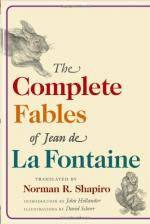|
This section contains 4,471 words (approx. 15 pages at 300 words per page) |

|
SOURCE: "Conclusion," in A Pact with Silence: Art and Thought in the "Fables" of Jeàn de La Fontaine, pp. 97-107. Columbus: Ohio State University Press, 1991.
In the following essay Rubin asserts that, contrary to the arguments of other critics, La Fontaine did not ignore the prevailing poetic styles and concerns of the time, but that in fact his Fables reveal his interest in the baroque style current at the time as well as the influence of contemporary writers such as the satirist Boileau.
A crucial problem of La Fontaine studies, and, more broadly, of the historiography of early modern French literature, is the seeming disconnectedness, even isolation, of the Fables from the general trend of seventeenth-century lyricism. While leading scholars concede that La Fontaine's masterpiece contains scattered borrowings from poems by Malherbe, Théophile de Viau, Tristan l'Hermite, and others, the Fables are viewed as a lieu...
|
This section contains 4,471 words (approx. 15 pages at 300 words per page) |

|


